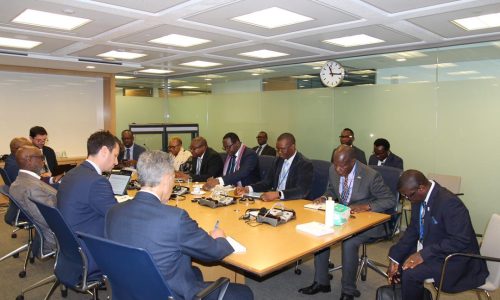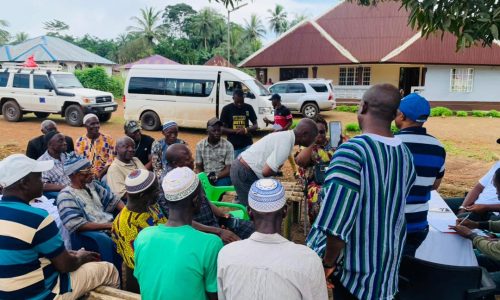By Fatmata Bintu Alhadi
Speech to the Freetown Dinner Club on 13th April 2024 by the Honourable Ms. Justice Fatmatta Bintu Alhadi JA, FPMA
- Mr. Chairman, Gentlemen of the Freetown Dinner Club, Distinguished Guests, Ladies and Gentlemen. Let me start by congratulating the Freetown Dinner Club on its 80th year of existence, being the oldest Dinner Club in the West African Sub-Region. Wishing you many more glorious years into the future as you continue to inter alia, exchange ideas leading to personal and professional growth.
- Thank you for inviting me to speak to this auspicious and venerable gathering and thank you to the delightful Speaker, Mr. Ibrahim Cole for introducing me.
- On your invitation in December of 2015, I spoke on public health and sanitation since the Ebola epidemic had just ended.
- This time, I wish to speak about the law on adoption of children in Sierra Leone, its inadequacies in the protection of children in respect of international adoption.
- Given the attention of the national emergency on illegal drugs and substance abuse, more specifically “Kush”, it is important that one should take this opportunity to raise an awareness about the growth of international adoption of Sierra Leone’s young and healthy children who are mainly under 5 years old.
- This presentation is based on Sierra Leone and the global context underpinned by evidence.
- One may wonder why this is happening. Many reasons could be proffered for Sierra Leone in particular, and other developing countries around the world as well.
- In Sierra Leone, the law that governs the adoption of children is the Adoption Act No. 9 of 1989. It is outdated and is being abused for this reason and needs to be reformed. The spirit of the Act was for the adoption of children aged under 17 years old, by their relatives related by full blood or half blood, or adoption by affinity.
- Affinity relates to a natural liking for and understanding of the child and would mainly be applicable to foreigners who would have worked and resided in Sierra Leone for at least 6 consecutive months and would have bonded with children under 17 by caring and having them live with them continuously.
- Then there would come a time when the foreign couple will have to move from Sierra Leone permanently. Since Section 2 (2) of the said Adoption Act provides that it would have to be a husband and wife, the couple would be eligible to apply to the court for an adoption order.
- There would certainly have been an established relationship in Sierra Leone and under these circumstances, the court will no doubt consider each application on its merit.
- The United Nations Convention on the Rights of the child signed in 1989 states that every child has the right to grow up in a family environment, to know and be cared for by her or his own family, whenever possible. Sierra Leone signed and ratified this Convention in 1991.
- The growing trend now is that young birth parents (ages 19 to 20’s) give up their young healthy babies between 6 months old and 3 years old, for adoption to total strangers, foreigners.
- They are being coached on how to take their children to orphanages who would match their children with prospective adoptive parents. Some say “are dae gee me pikin to wate man. Den go men we pikin dem for we.” Many of the applicants are mainly from South America, The Mediterranean and Eastern Europe.
- There is no doubt that one of the reasons for this attraction to Sierra Leone is because Sierra Leone is not a signatory to the 1993 Hague Convention on the Protection of Children and Co-operation in respect of Intercountry Adoption. As of March 2019, the Convention has been ratified by 99 countries.
- The Convention is an important development for children, birth families and prospective foreign adopters. It sets out obligations for the authorities of countries from which children leave for adoption, and those that are receiving these children.
- It is designed to ensure ethical and transparent processes. It is an international legislation that considers the best interests of the child and provides the framework for the practical application of the principles regarding intercountry adoption contained in the Convention on the Rights of the Child. It ensures that inter-country adoptions do not result in improper financial gain for those involved in it.
- The Hague Convention on Adoption of Children of 1993 has “caused a real shake-up” because a lot of social agencies in developing countries simply can’t comply.
- In some cases, adoptions have not been carried out in ways that served the best interest of the children, where the requirements and procedures in place were insufficient, to prevent unethical practices such as, the sale and abduction of children, coercion or manipulation of birth parents and falsification of documents.
- There are multitude of problems that many developing countries face and that drive the supply of young children: extreme poverty among families, weak social welfare systems to find alternative family arrangements closer to home and legal systems that operate on personal deals rather than legal principles.
- Many of these foreign adopters are from countries which are signatories to the Hague Convention, and they go through their home authorities. The issue tends to be with the private adoption agencies which charge fees for their services in connecting prospective adopters with the orphanages and lawyers in the countries of the children.
- As a result of these challenges, a huge industry of adoption agencies, orphanages, and adoption law specialists, who command large fees – often between US$20,000 to US$40,000 per child has developed.
- And while some adoption agencies do their work legitimately, the lure of such large fees has created powerful incentives for less legitimate agencies to procure children.
- Other reasons for the increase in international adoption include:
- Higher rates of infertility in couples who have delayed parenthood, increased number of children who are relinquished, abandoned, or orphaned around the world; the influence of 3rd party agencies, who strongly influence and facilitate the child migration process.
- In some countries, such as Guatemala, Marilys Barrientos de Estrada, a director of the governmental agency created to oversee the new adoption process, reported that “the government had lost control of the system; it was purely in the hands of the lawyers and agencies, and it wasn’t about the children, it was about the money.”
- The risks and vulnerabilities that Internationally adopted children face is numerous. They include loss of their family, country, language, and culture.
- Critics argue that international adoption helps a relatively small no of children who find adoptive parents but may impede countries from developing social programmes that would benefit many children who are suffering, due to poverty or social and political problems.
- Commercially driven agencies are frequently involved in facilitating adoption placements from overseas countries.
- In the international adoption arena, wealth or buying power is often able to facilitate adoption placements. Adoptive parents may have greater choice in the age and background of the child and a shorter waiting period if they are willing to spend significantly more money than they would for a national adoption.
- Along with the increasing demand for and rapid growth in international adoption, growing concerns have been raised by or on behalf of sending countries. They have mainly centred on:
(a) an increase in the demand for younger, healthy infants. This may lead to the removal of the most adoptable children from their own countries and the children who are left behind are statistically, less likely to be adopted.
(b) The removal of children from their birth culture and kin. This is because international adoption often results in a permanent removal of a child by the financial and geographical barriers to continued contact with birth culture and kin. This may have implications for the future development and identity rights of the internationally adopted child.
(c) Circumstances of poverty often create greater vulnerability. The unremitting poverty and hardship experienced in poorer sending countries often make birth parents more vulnerable to pressure to relinquish a child for financial gain. A lack of support services and poverty, increase the likelihood of abandonment of children if birth parents feel they are giving the child a chance at better care. Postadoption opportunities for contact are limited, either by the nature of the adoption, or by the inability to practice openness because of the distance and financial resources required.
(d) Market-Driven Economies Introduce New Risks for Children. The current rapid growth in the movement of children across borders and the increased demand and supply of children has resulted in market-related conditions developing for the legitimate trade of children. Under these conditions, it becomes difficult to protect the rights of children and the “best interest of the child” are less and less likely to be taken into consideration. Market related conditions for adoptions raise concerns that the legality of an adoption process may be compromised on account of the wealth or financial status of the adopter or of their representing agency.
The question that therefore arises is: What can be done?
- In many countries, international adoption is not the first solution. The child needs to be re-established on the ground before you look for external solutions.
- With stricter adoption policies in place, children can be more likely to be matched with a family in their own country than with one overseas.
- A new system that follows the Hague Convention on intercountry adoption which is an international standard should be put in place.
- There ought to be a robust registration of births, and registration of adoption with all the details of birth parents and so on.
- A UNICEF inspired policy could be implemented where systems to facilitate local adoptions, where a family within the country, preferably a relative, should be sought before international families.
- Parliament and the Ministry of Social Welfare can put a cap on international adoptions not more than a certain % of adoptions in a year. This will require keeping accurate statistics on adoption both local and international and reporting to the public on the data.
- The Hague Adoption Convention of 1993 makes adoption a transparent, predictable, and legitimate process.
- Legislators can make a concerted effort to put domestic adoptions first.
- In some countries, government pays families a bonus of up to $1,000 for taking a foster child with generous monthly payments for upkeep.
- Support is needed to strengthen child protection systems.
- Our development partners and civil society need to work with our social welfare authority to protect vulnerable families to ensure that robust legal and policy frameworks are in place and to build capacity of the social welfare, justice, and law enforcement sectors.
- Although in no way invalidating the rights of individual children to a better and more stable family life, we must acknowledge our responsibility to strive for the same conditions and opportunities for all children regardless of the country of their birth.
- And on that note ladies and gentlemen,
I thank you for your attention.






